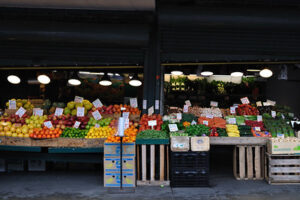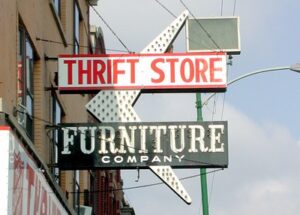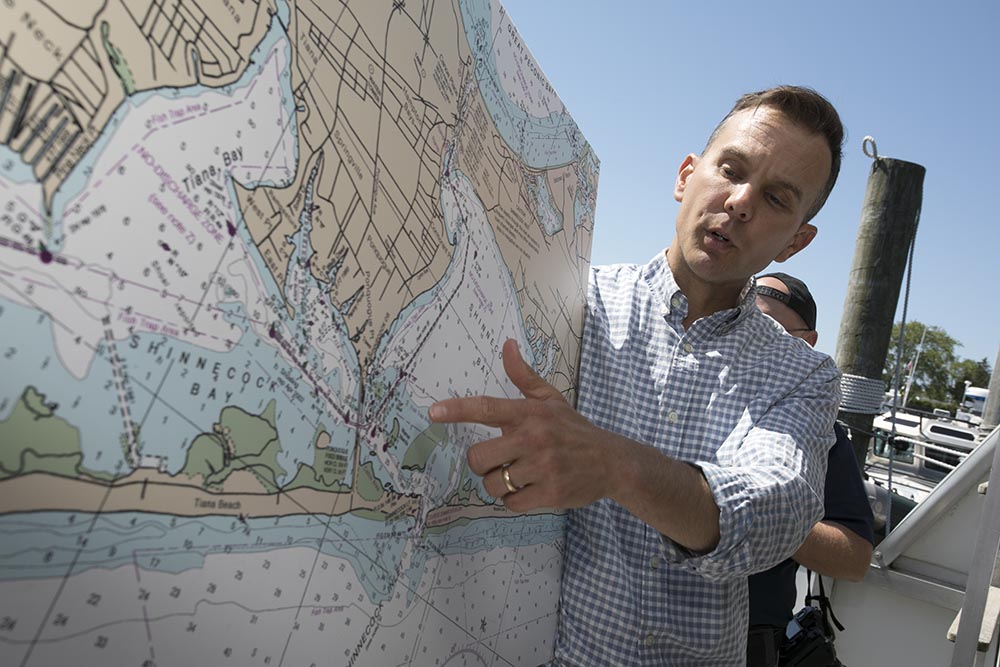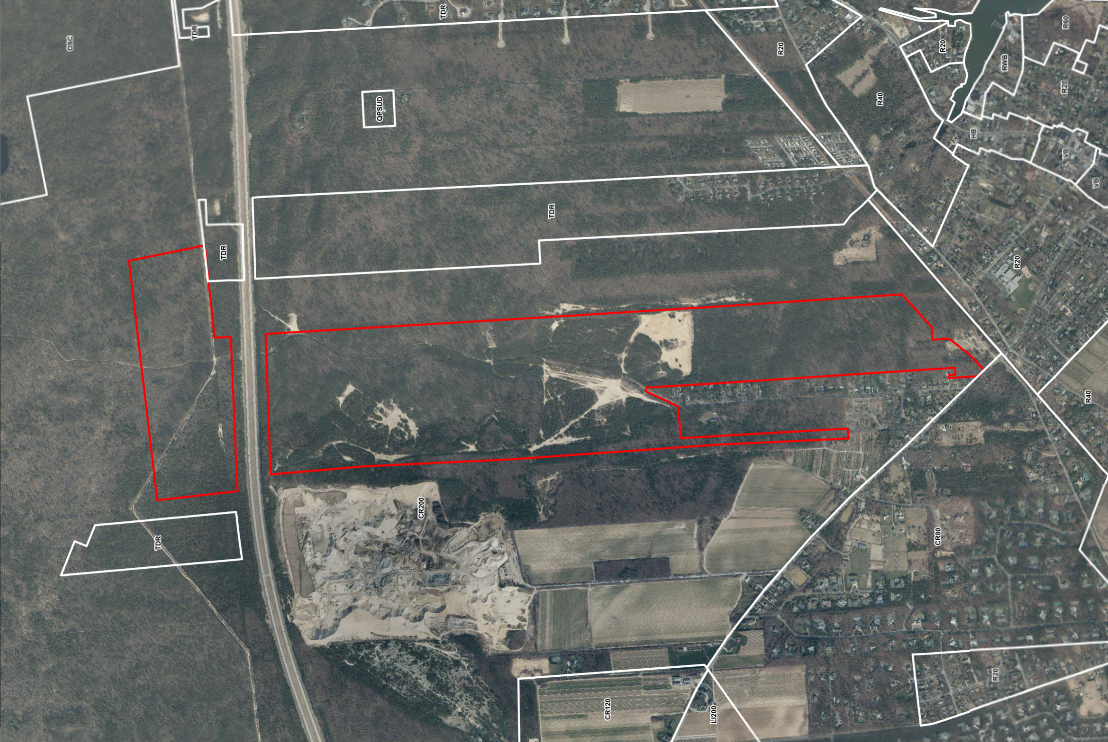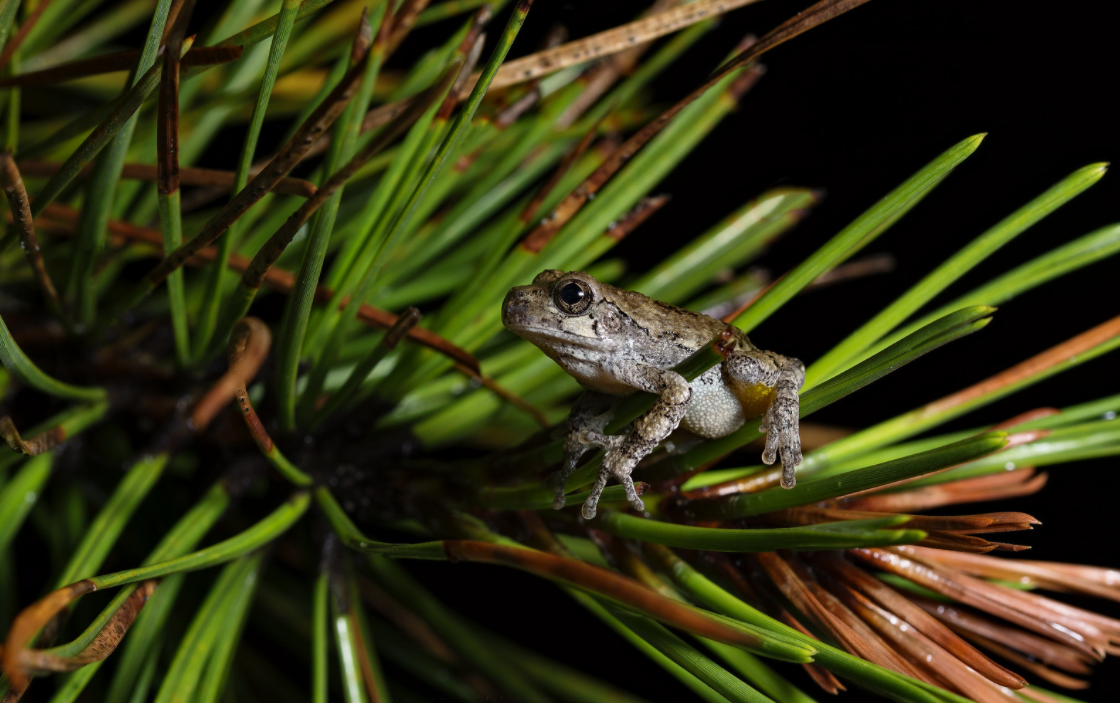How to Celebrate a Sustainable Holiday Season

The holiday season is here, and that means it’s the time for togetherness, giving, and pure joy, right? Well, for some. There’s no denying participating in festive events increases holiday spirit, but when you look at the environmental impacts you may think twice about how you celebrate. If you struggle with eco-anxiety, like myself, perhaps these statistics will influence you to adopt sustainable practices for your holidays.
Research shows that our trash production in the United States increases by 25% between Thanksgiving and New Years. That amounts to about an additional 25 million tons of waste sent to our landfills to be burned, emitting greenhouse gases that will accelerate the impacts of climate change. So, you see, throwing away a few plastic forks can snowball into an alarming impact (and this may be the only type of snowballing we may hear of this winter if we don’t combat the climate crisis now!). If you feel inclined to go-green this holiday season, I encourage you to follow some of the tips below for each holiday! And, if you want to incorporate sustainable practices in your daily life too, head to our Facebook page to stay updated on our weekly sustainable tips.
Sustainable Thanksgiving
Give thanks by preparing a locally-made feast! Long Island provides several farms or farmers markets to buy local produce. Check out some of these markets when food shopping for your holiday: Sea Cliff Farmers market in Glen Cove, Natural Earth Organic Farms in Calverton, or look up some local markets/farms in your area!
So, you’ve provided your family with locally sourced food but what else can you do? Encourage your family to come prepared with their own tupperware containers! Arguably one of the best parts of Thanksgiving is snacking on leftovers for the next week! You can kill two birds with one stone when you bring your own tupperware by eliminating food waste, and avoiding disposable containers or plastic wrapped plates!
Sustainable Hanukkah/Christmas
By December 1st, the Holiday season will be in full swing. And let’s be honest, who doesn’t love shopping for gifts with a hot chocolate, and Mariah Carey’s Christmas album on repeat? You don’t have to stop these traditions to have a green holiday. Sustainable shopping starts by staying mindful. Perhaps instead of shopping at the mall, look for companies that use sustainable practices, or only buy gifts the receiver will use! Better yet, give the gift of an experience.. A gift of an experience eliminates the waste of gift wrap, which contributes a large portion to the holiday waste. If you opt for a gift that needs to be wrapped try finding recycled wrapping paper or get crafty and use old newspapers, twine or any other unused fabrics laying around your home!
Another significant part of the holidays are the decorations! When decorating your homes this year aim to purchase LED lights that use less electricity and last longer. Bring out that crafty side again, and create your own decor with things you may find outdoors! Also look for natural candles for your menorahs to avoid the release of harmful chemicals.
Sustainable New Year
While New Year’s Eve parties may look a little smaller this year, we must still consider the environmental impact of our gathering. In preparation for your party, avoid buying single use decorations or utensils. If you can’t avoid this, try swapping for a biodegradable option.
A New Year’s Eve party wouldn’t be complete without at least one person showing up in those notorious sparkly outfits. If that person is you, try to shop secondhand. A study done in Great Britain states that about 8 million pieces of clothing get thrown in the trash after being worn once to a holiday party. Protest fast fashion by using the many online secondhand outlets, such as Poshmark, ThreadUp, or Depop. If this wont work, take a look through your local thrift stores, or a sibling’s closet!
Lastly, come up with an eco friendly resolution….except don’t wait until 2021 to start. The best time to start living environmentally friendly is now! Your small lifestyle changes will make an impact, although it may not seem like it. Hopefully these tips will help you celebrate a sustainable holiday season!
By Miranda Gonzales, Long Island Pine Barrens Society
Posted on November 23, 2020 by Long Island Pine Barrens Society
Five Questions with the Sierra Club
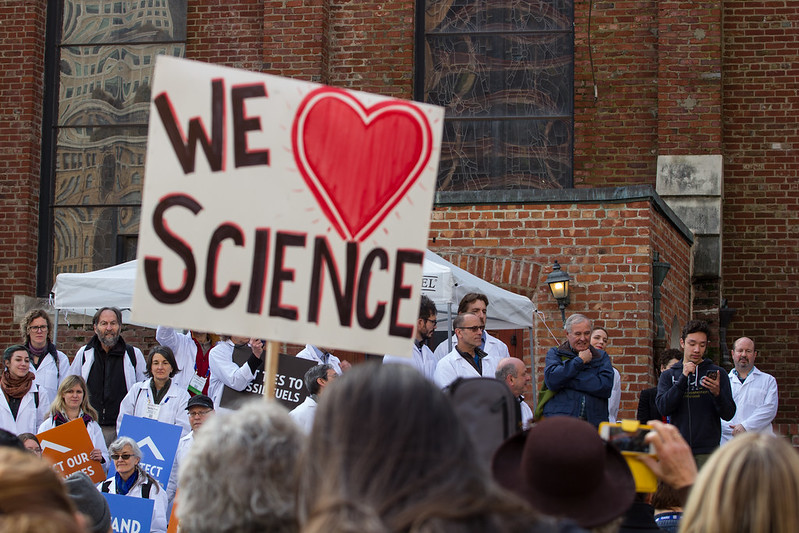
The Long Island Pine Barrens Society is continuing on with our blog feature called “Five Questions with an Environmentalist.” We have interviewed a variety of people who are involved in protecting Long Island’s natural environment – advocates, scientists, artists, educators and more! Each person has their own unique perspective and we are excited to share their voices over the next few months.
This week, we are delighted to share the interview we had with Jane Fasullo- a loyal volunteer at the Long Island branch of the Sierra Club! Let’s jump right into the interview!
1. Can you please tell us a little bit about your background?
I was born in Queens, that’s where I grew up when I was not in the Hamptons. The family was lower middle income but my mom was determined to give us a lot of outside time. So, we had a homemade, pull-behind, car trailer and an old army tent that the family lived in (mom, me and my older sister) all summer at Montauk State park. I was born in late May and taken to the ocean to “swim” in June. Mom felt I would learn how to dog paddle faster if I had to, and I did. Dad traveled back to the city to work during the weeks and joined us on weekends. So, mom learned how to use the natural foods to supplement our diet – blackberries, blueberries, wild grapes, beach plums, fish that dad caught on weekends along with clams, oysters and crabs gotten out of Napeague Harbor. When home in Queens (Whitestone), mom would make sure we were out playing every non-rainy day. We also took some day trips with the tent in the early spring and fall stopping at campgrounds around the state. When Montauk state park no longer allowed full season camping, we moved to a camp on Napeague Harbor. Dad built a “cabana” composed of bolted together 4 by 8 panels and an aluminum framed canvas roof for use at Napeague. There, being right on Napeague harbor, a much quieter body of water than the ocean and rich with seafood, we regularly clammed, fished, crabbed, etc. My folks moved our winter home to Syosset around the same time as the camp at Napeague was sold. So, mom and dad looked for land to build something on from Sag Harbor east to Montauk. They chose a parcel between Three Mile Harbor and Gardiners Bay with waterfront on both waterbodies. We continued to use the cabana on a platform dad constructed for the summer time for two years then mom and dad with some help from me, built a small house. We pumped, by hand, our own water. That was the best water I’ve ever had! While the house was under construction, my younger twin-sisters were born. Mom was pregnant when a severe hurricane hit out east – the worst one I have ever gone through. But that’s another story. We continued to eat off the land when we could and I loved going berry picking and eating those wonderful toast-tite pies – mmmm GOOD!
I tell you this so you have a good idea of why I put a lot of time now into protecting what little of that wonderful life remains.
Upon finishing high school in Syosset, I bucked my parents and went to college. To do it had to save every penny I could from working as a babysitter while going to junior and senior high, and from my summer job with as a cashier at a local electronic store (in my senior year). I moved back to Whitestone to live with my paternal grandmother so I could go to Queen College free, but I hated Queens college so I transferred to Stony Brook after one semester because scholarships paid my tuition and books while jobs on campus paid my room and board. I finished as a mathematics major with a computer minor though I always liked doing architectural design (and still do like to do floor plans for solar homes). After graduation I worked as a math teacher, a computer instruction lab manager at Stony brook U., and a part-time as a real estate salesperson. Along the way I earned a master’s degrees in general studies with electives all in science, and I attended Suffolk Community College where earned two certifications – one in drafting and one in computer programming. But from the day I was born, I loved watching nature.
When I retired, I looked for a way to keep busy. I wanted to do something for the environment. Only the Sierra Club had opportunities for people like me who wanted to make a difference for the environment but did not have a degree in science, environmental science, management, or the like.
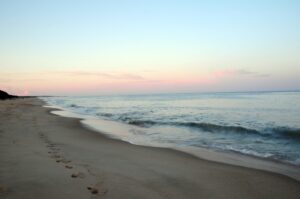
Montauk – Jasen Miller
2. What are some of the programs that the Sierra Club offers on Long Island?
As an all-volunteer entity with no office and no staff, running programs depends entirely on who will volunteer to do them. And we can only run those that someone wants to do.
At the moment, we have only two programs; a citizen science water testing program and an outing program. The water testing program tests for some basic water quality items such as temperature, turbidity, Ph, salinity, etc. We record the data on our own website but would LOVE to have one that contains our data along with that from other programs – I think the Nature Conservancy may be looking to set up such a universal site. The outings program takes club members and people from the public into the outdoors on hikes, bicycle rides, and kayaks. On a vast majority of the events, educational discussions are held about what is being seen and what is needed to protect our natural surroundings.
Most of what we do is educational. We have a tabling program where we go to events other entities are offering and hand out information about the state of the environmental, actions they can take to help protect it, world issues such as global warming, and so on.
We also work with other organizations on programs they create and need either physical or financial help with. We are able to do advocacy and have both a political committee that mainly recommends the endorsement of local political candidates and a legislative committee that advocates for and comments on legislation. The Club has a national staff person who works on energy matters here on Long Island. Before she arrived, we had a local energy committee working on Long Island energy issues. Now, instead of our own energy committee, those who are interested, mostly work with that staff person, though many of us still comment on and promote smart energy development. We had hopes of starting a beach/park clean-up program this summer but Covid-19 put a hold on that. We also have taken legal actions against private companies and the government when it is clear environmental damage has been done that needs to be corrected.
3. What are some of the volunteer opportunities that the Sierra Club offers on Long Island? How can individuals get involved in Sierra Club’s work?
We don’t have many opportunities for short term volunteers. Even the citizens that do the water testing have to be regulars and be trained, likewise for the outdoor program event leaders. But we need volunteers who are able to commit some serious time to starting up programs, doing advocacy, joining or heading up committees, becoming certified to be an outdoor leader/educator, manage the tabling events, and so much more.
4. What do you see as the biggest threats to Long Island’s environment?
Everything! Poisons that are killing off our insects and hurting humans, draining down our aquifers by using sewers that do not clean the water enough to be spread on the surface to recharge the aquifers, overdevelopment, poor waterbody quality which is killing off our seafood, global warming causing flooding and changing the species that can survive here, and on and on. Asking what is most important is like asking me to pick out the best piece of straw from a haystack.
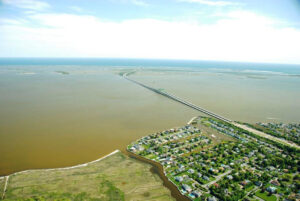
Brown Tides- Long Island
5. Do you have a favorite Pine Barrens park and why is it your favorite?
I love every undeveloped piece of land on Long Island, even some just in the early stages of recovery. Each has its own characteristics and again, it’s hard to pick out one. Some have water ponds, some have water front, some have nothing but dried uplands that some consider boring, but that provide habitat for things that live nowhere else. Some include historic uses like the cranberry bogs but which show how nature can recover in spite of our abuses. Some have almost no oaks and some are nearly all oaks. Each has its own special properties. And I love them all.
Posted on November 16, 2020 by Long Island Pine Barrens Society
Nature Deficit Disorder
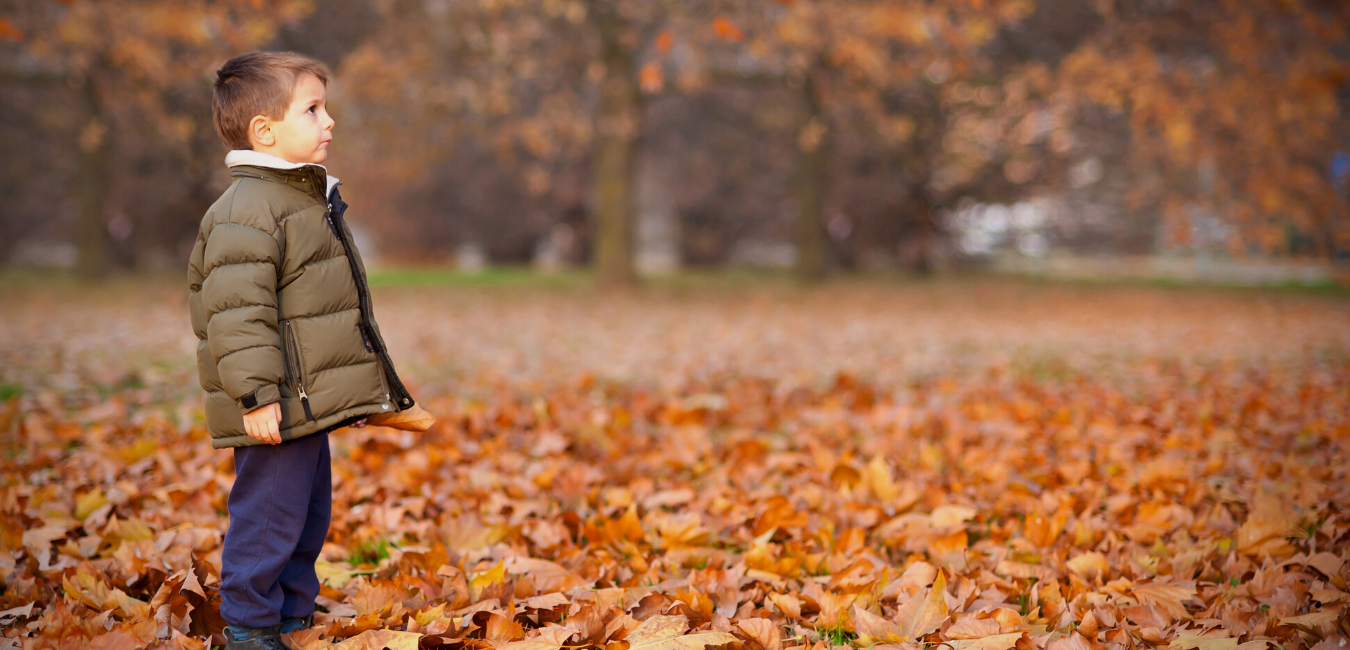
Nature Deficit Disorder, a term coined by Richard Louv in his book, Last Child in the Woods, describes the behavioral impacts of children spending less time in nature and more time indoors. Some side effects include: increased childhood obesity, attention disorders, and depression. The Coronavirus pandemic makes it even harder for kids to get outside, so we must do what we can to make sure children get the outdoor experience they need.
To combat Nature Deficit Disorder, some schools have created environmental education programs, green school yards and natural playgrounds. We need to push for advanced environmental education programs in Long Island public schools so our kids can truly learn and appreciate how the natural world works. It’s equally as important to promote outdoor playtime. Constructing green school yards or natural playgrounds will give students a much-needed break from the sedentary classroom life. Some schools with these strategies see improved test scores, less bullying, and happier students overall. With the benefits being clear, why haven’t we seen public schools push to connect their students with nature?
While we wait for schools to incorporate class outside, what can you do to ensure your child doesn’t suffer the consequences of Nature Deficit Disorder? You can start by limiting screen time, but this won’t be enough. You must take your kids outside! Even adults need to reignite their adventurous side every once and while. Maybe you want to take a hike through the pines, or go bird watching, but don’t know where to go. We’ve got you covered at the Long Island Pine Barrens Society. Check our recreation tab on our website (www.pinebarrens.org/recreation/) and choose the activity you want to do! We’ll map it out for you, you just need to choose where to go!
Learn more about Nature Deficit Disorder in our upcoming newsletter – stay tuned!
By: Miranda Gonzales, Long Island Pine Barrens Society
Posted on November 10, 2020 by Long Island Pine Barrens Society
Clean Water is on the Ballot

This upcoming election is important for a lot of reasons. When you receive your ballot, you’ll choose your names on the front side (you’re on your own with that). However, it is extremely important that you flip your ballot over and check out the propositions on the back.
If you live and vote in Suffolk County, you’ll have two or three propositions on your ballot, depending on what Town you live on. Pay careful attention to Proposal No. 2 (Resolution 547-2020). Suffolk County Politicians are trying to raid your Drinking Water Protection Program again.
Suffolk County has carefully worded the proposition in a way that makes no sense, so that you know what they’re actually up to. But make no mistake, they are asking for your permission to raid a fund of your tax dollars that you have already designated for water protection.
Here’s the language you’ll see on the ballot:
PROPOSAL TWO, A PROPOSITION
Resolution No. 547-2020, “A Charter Law to Transfer Excess Funds in the Sewer Assessment Stabilization Reserve Fund to the Suffolk County Taxpayer Trust Fund and to Eliminate the Requirement that Interfund Transfers Be Made from the General Fund to the Sewer Assessment Stabilization Fund”
Shall Resolution No. 547-2020 be approved?
( ) Yes ( ) No
Makes a lot of sense, right? (That was sarcasm, in case you missed it.)
Here’s the deal.
A Vote AGAINST Suffolk County Prop #2 (NO Vote) –
- Would enforce a court ruling that requires the repayment of tens of millions of dollars illegally raided from the Drinking Water Protection Program Fund
- Would ensure the availability of money to protect residents’ drinking water
- Would maintain enough money in the tax stabilization fund to assist taxpayers in existing and new sewer districts
A Vote FOR Suffolk County Prop #2 (YES Vote) –
- Would move funds from the Drinking Water Protection Program to a general fund, which can be used for whatever politicians want.
- Would “forgive” the repayment of tens of millions of dollars back to the water protection fund, that had been previously illegally raided
The Suffolk County Drinking Water Protection Program (DWPP) was created by voters in 1987 by an 87% majority and has been extended several times since. It uses a ¼-percent in sales tax to fund important water quality improvement initiatives, the preservation of open space, and control taxes for those in sewer districts.
Unfortunately, Long Island has the most contaminated water in the state. It also has some of the highest concentrations of nitrogen in our groundwater in the country. This is a public health crisis, that we cannot ignore. We cannot afford to raid the Drinking Water Protection Program.
So, join us, alongside countless other environmental and civic organizations to VOTE NO on PROP 2. To learn more, please visit https://www.pinebarrens.org/voteforcleanwater/.
Make a plan to vote. Visit https://www.vote411.org/ to register to vote, check your voter registration status and find your polling place.
Posted on October 5, 2020 by Long Island Pine Barrens Society
Five Questions with a Pine Barrens Educator
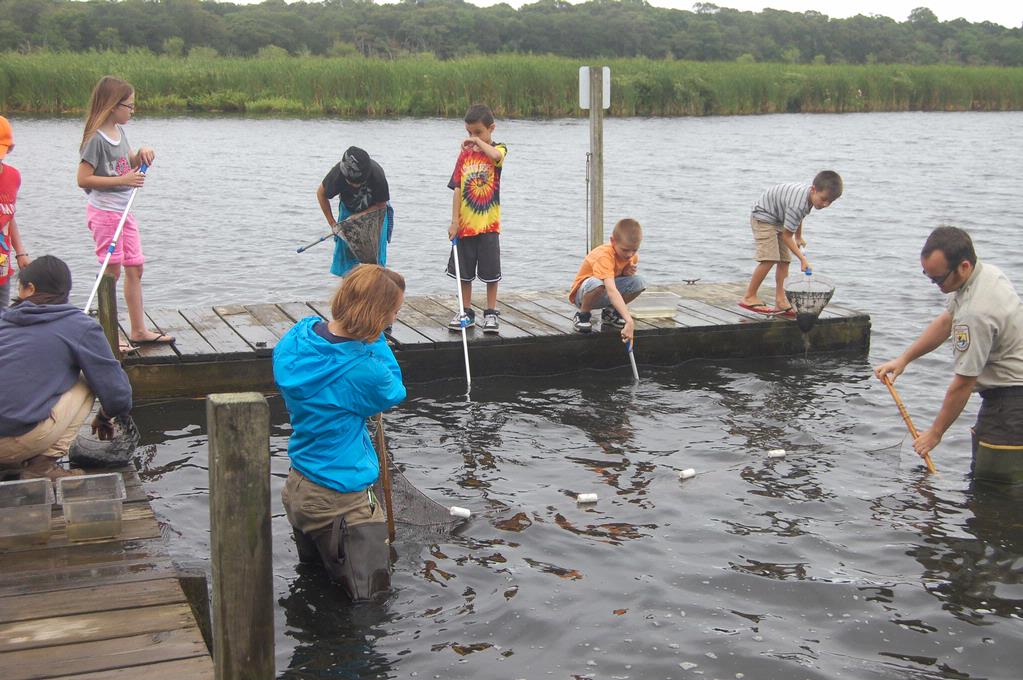
In this latest installment of our “Five Questions with an Environmentalist” blog series, we’re welcoming Melissa Griffiths Parrott, the Education and Outreach Coordinator for the New York State Pine Barrens Commission.
First, just a quick note: We (the Long Island Pine Barrens Society) are often confused with the New York State Pine Barrens Commission and vice versa – so, we thought we’d clear up some confusion! The government agency that oversees protection of the largest section of Pine Barrens is the Central Pine Barrens Joint Planning & Policy Commission. Created by landmark state legislation, the Pine Barrens Protection Act of 1993, the Commission is responsible for producing the Comprehensive Land Use Plan for the Central Pine Barrens, holds monthly meetings to consider limited development possibilities and is responsible for stewardship of protected lands.
Our Long Island Pine Barrens Society is a non-profit, whose mission is to advocate for and educate the public on matters of land preservation and drinking water protection, especially in the Pine Barrens. The Society attends meetings and stays in contact with the Commission to ensure proper adherence to the Land Use Plan and to collaborate on efforts to improve the protection of the Pine Barrens.
Now, let’s learn from Melissa!
1. Can you tell us a little bit about your background? How did you end up at the Commission?
I like to say Point A to Point B is not necessarily a straight line.
I grew up in Southern California and graduated from California State University, Long Beach with a BA in Radio/TV and Film. (Yep- remember that squiggly line from A to B?). Before I graduated, I studied abroad in London, England and took a gap year to live in Florence, Italy, becoming fluent in Italian. After graduation, I worked in two fields that I was most passionate about; Natural History and TV/Film. While I was a production assistant with various producers and studios, I was also a docent educator at my local nature center and the assistant Outreach Coordinator at the Los Angeles Natural History Museum.
I finally landed the job of my dreams, Post Production Coordinator for ABC/Kane TV. ABC/Kane is the documentary division of ABC television. I was able to combine my two passions, of nature and TV and film. I was in heaven! After some time working in the film industry, I realized my passion for the natural world was stronger. I knew I had to follow my stronger feelings, so I left the entertainment industry and dove head first into working in the Environmental Education and Outreach field. Along the way, I went back to school and trained to gain the knowledge and skill set needed to be the best at what I wanted to be! After about 20 years as an environmental educator, working as a Director of Education at Sweetbriar Nature Center in Smithtown, Director of Environmental Education for the Commonwealth of Massachusetts (yes, for the Governor!!), and Director of the Sport Fishing Education Center for Cornell Cooperative Extension along the way, the Education and Outreach Coordinator position with the Central Pine Barrens Commission was recommended to me by a friend. After some research into the position and the Commission, I thought it would be a great stepping stone for me with the ability to create a brand new Division within the Pine Barrens Commission. That was in 2007 and I’m still here!
2. What kinds of educational programs does the Commission offer?
What don’t we do! We can certainly tailor any of our programs to fit a variety of needs. Although we are a Pine Barrens-based Commission, we do provide educational opportunities across our Pine Barrens boundaries, everything is connected, so we teach from a holistic point of view, including all Long Island habitats and ecosystems.
Our main educational programs include our Barrens to Bay Summer Camp- One of my favorite parts of the year. We partner with Wertheim Wildlife Refuge and provide 6 weeks of hands-on, fun and creative ecosystem-oriented educational programing at the Wertheim Wildlife Refuge for ages 6 –12. We explore the trails, seine the Carmans river, partake in water quality and biodiversity studies, animal tracking, microscope discovery and hands on time with live animals and other specimens. It. Is. The. Best.
We also co-sponsor with Brookhaven National Lab and NYS Department of Conservation, for our annual A Day in the Life program. We partner students, teachers and natural resource experts with 11 aquatic ecosystems across Long Island. It is so much fun!! We train the teachers, work with the students and partner with the best natural resource experts on the Island. We also get to travel to some of the most beautiful locations on Long Island, including the Carmans River, Peconic Estuary and Fire Island to do a deep dive into its environmental health! The students learn real world scientific techniques to test the water quality, inventory biodiversity and more, to become true citizen scientists! They also connect with their natural world, which is so important for long term conservation.
Every Fall we partner once again with Wertheim Wildlife Refuge to host a Pine Barrens Discovery Day! A day of learning and experiencing the Pine Barrens. The entire day is full of “fun shops” tailored to a variety of levels to either be introduced to the Pine Barrens or learn more! Some of our past presentations include: LIVE Birds of Prey, Marine Life, Native Plants, Sharks and Whales of Long Island, Long Island Bats, American Eels, Forest Rangers, Wildlife Forensics, to namejust a few. We also have expert Naturalists guide walks along the trails of the Refuge and on the Carmans River. We seine and dock scrape for some in-depth hands-on aquatic life fun. It’s a GREAT day!
We also provide fun in-class presentations on Pine Barrens Ecology, Long Island Biodiversity and Climate Change on LI (yes, we do try to make that one fun too, or at least end on a positive note).
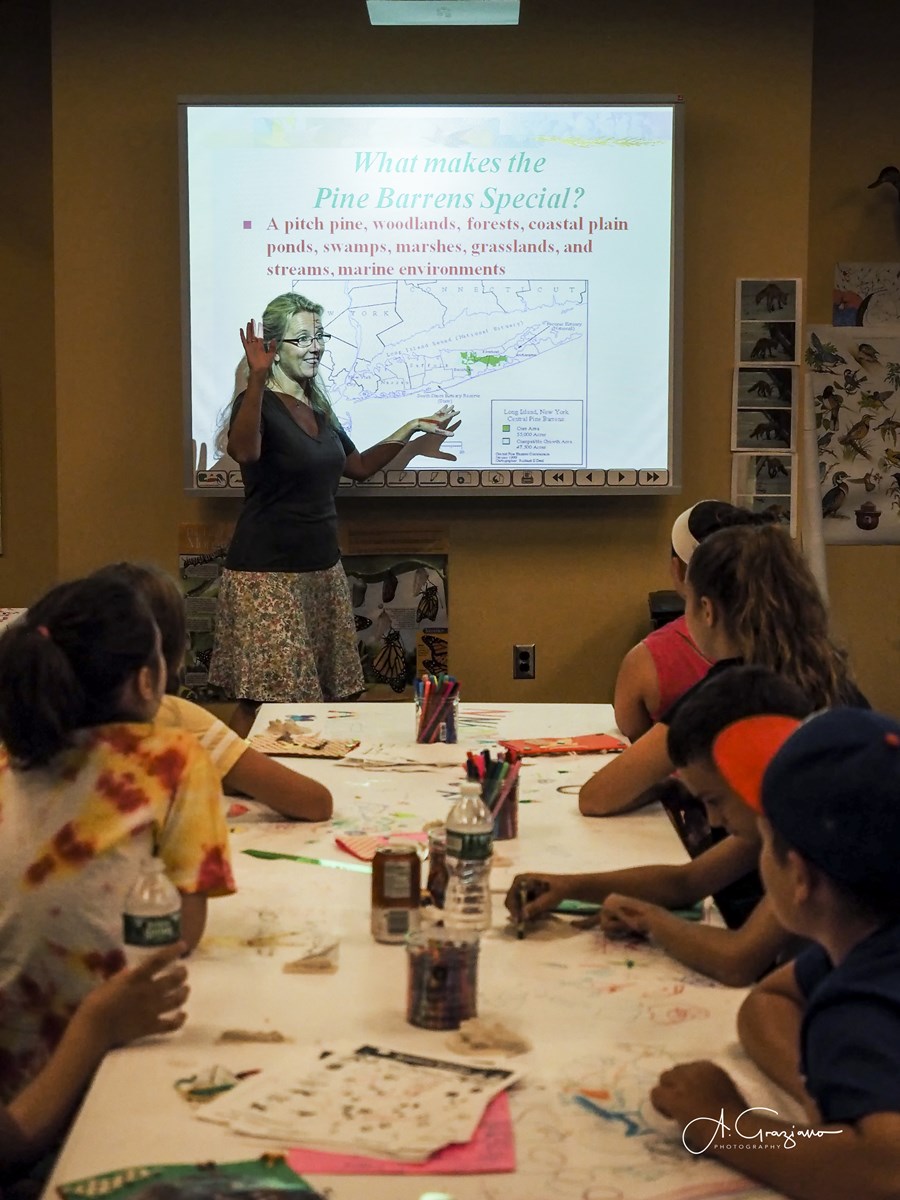
Melissa Griffiths Parrott teaching a Pine Barrens Lesson. – Credit: A. Graziano Photography/ Pine Barrens Commission
3. What subject do your students seem most interested in?
Without a doubt wildlife! Hands Down. It engages every age level with their eternal curiosity and connection to animals, insects included! There is nothing more exciting than to see a student get excited about nature! I actually believe we are all kids at heart, because honestly, I still get excited about seeing any animal in the wild. It is such a treat and really a rarity!
4. What is your favorite Pine Barrens park and why is it your favorite?
That is a tough one. There are a few I connect with. Wertheim Wildlife Refuge along the Carmans River is my second home. Whenever I am on the trails or on the river, I am at peace and feel excited to explore. I have experienced so many surprises there when it comes to wildlife. You just never know what you will see! I also love the Dwarf Pine Plains, that happen to be right next to my office (Lucky me!). This trail, depending on the season has many surprises for you – Including orchids, deer, fox, whippoorwills and the endangered Coastal Barrens Buckmoth in the fall. This trail is rich in what makes the pine barrens the pine barrens, sandy soil, scrub oak, bearberry, huckleberry, lichens, and the globally rare, dwarf pitch pine tree. I also love any trail in the Pine Barrens that ends at the Bay or Sound. The Pine Barrens Maritime history is rich!
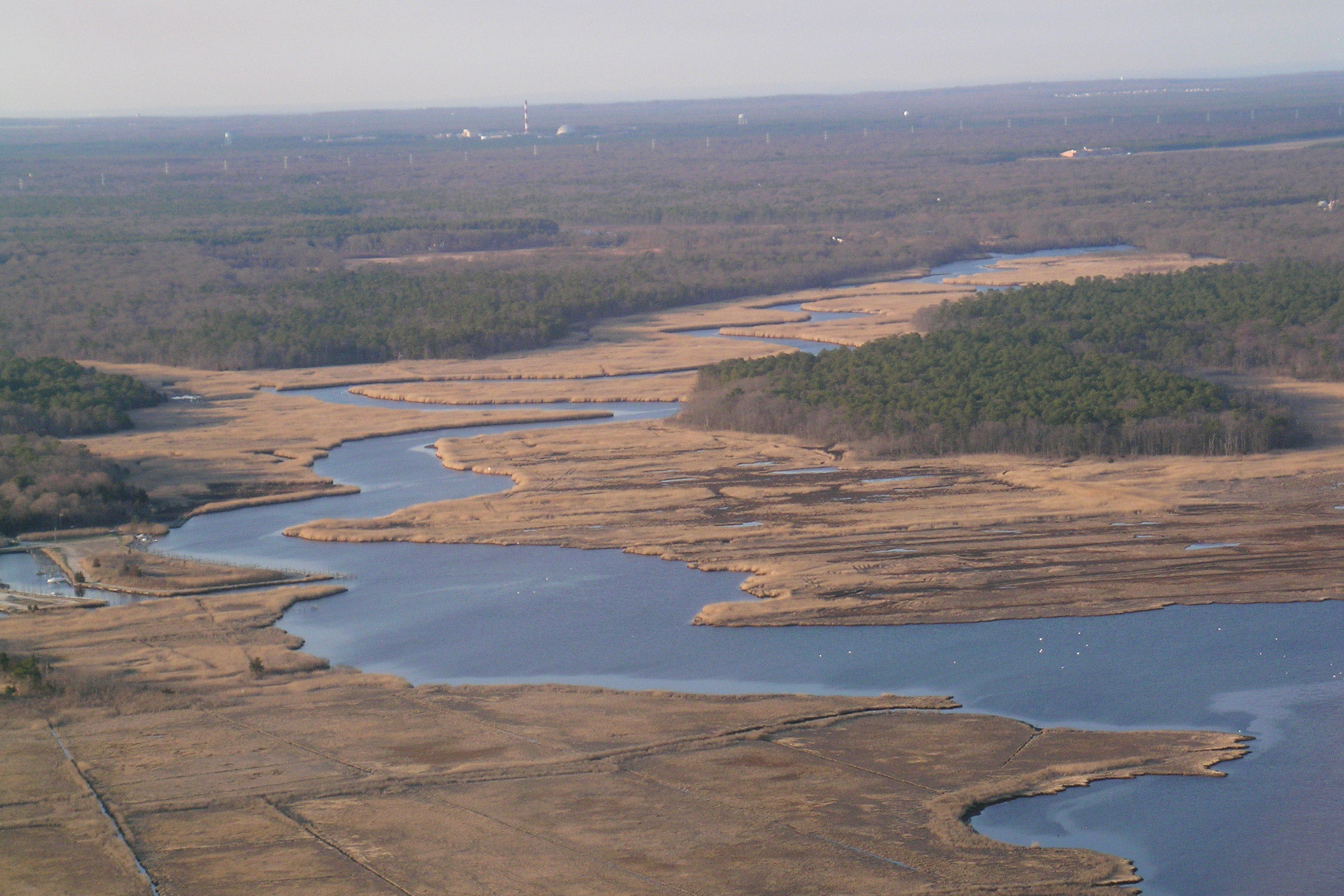
Carmans River – Photo by Julie Clark
5. Do you have any advice for the younger generation or the future stewards of our environment?
Explore. Ask questions, lots of questions. Don’t be afraid to do something you’re interested in. Pick up that stick and check out that scat. Enjoy your time outside and connect with your surroundings. Skin your knees, get dirty, experience YOUR LOCAL outdoors. Sit. Be still and listen. Observe. Be patient. Watch that butterfly or that bird, try to figure out what it is doing. It’s fun! As far as stewards of our environment; you protect what you love. It is your future and one day, YOU will be the decision makers that can protect our natural world. We will need you to do so.
Posted on September 14, 2020 by Long Island Pine Barrens Society
Backpacking Practice for Beginners in The Long Island Pine Barrens
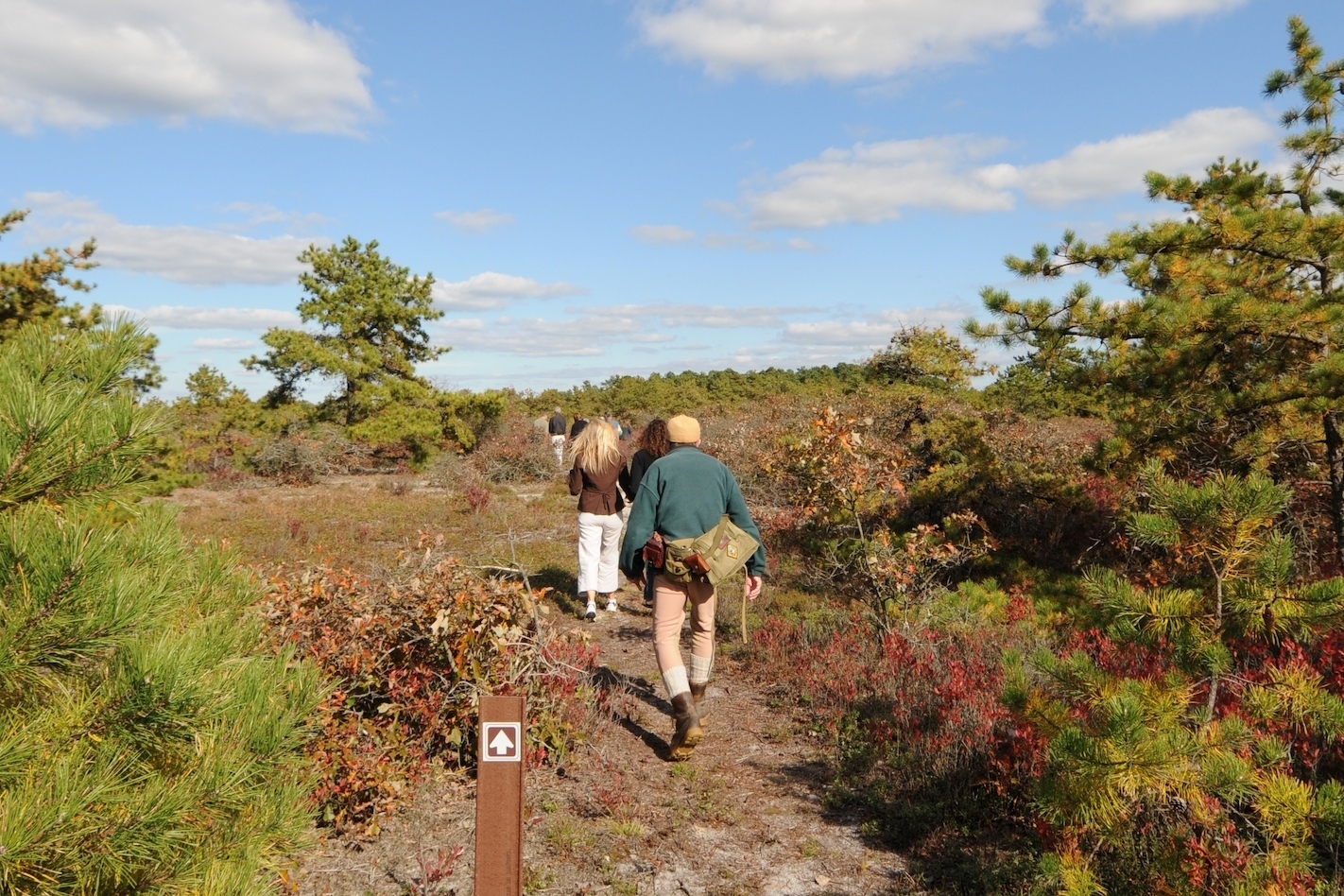
Hiking, much like backpacking, is the act of walking through nature on trails or even an unknown path. Backpacking, however, is the act of hiking over the course of a few days or more. Backpacking is not something you go and do spur of the moment. It takes strategic planning and some research. Without planning and research, you could easily find yourself in unsafe situations. For these reasons, the Long Island Pine Barrens is the perfect place to practice and get yourself ready for that backpacking trip you’ve been thinking about, but are not quite prepared for yet. Always know before you go! Do your research, practice, plan, map it out, and pack appropriately. Have fun, but most importantly, be safe!
Unfortunately, Long Island is not set-up or suited for backpacking as Suffolk County and the NYS Parks Departments do not allow overnight camping in places where there are not designated campsites. However, a hike along the Pine Barrens’ Paumanok Path or along other trails, is a great way to practice your stamina and endurance for a longer backpacking trip. Many people take long day hikes on Long Island to gear up for a longer backpacking trip in places like Upstate New York. After all, practice makes perfect!
Below are the steps you should take when planning and preparing for a backpacking trip, so take these steps into consideration when practicing in the Pine Barrens for that future backpacking trip elsewhere.
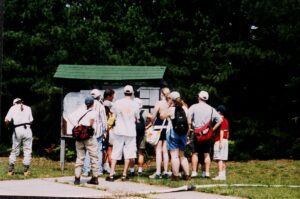
First Step: Where to go?
Before setting off on your backpacking trip, do your research and pick a destination because you cannot plan without first having a destination. Picking the right destination that best fits you and your experience is very important. If you have never backpacked before then you must choose a beginner’s trail that is easy and you should stick to one overnight. If you are a beginner, you should also try and go with someone who has backpacked before.
- Know your skill set and pick a trail that is well marked if you are not an experienced backpacker.
- Pick a season that suits your experience because weather plays a huge factor in what you bring on the trip.
- Do not just go ahead and wing it!
- Do your research and prepare yourself by reading about all things backpacking.
- Look up the trails before you decide to go anywhere and know how many miles, what pace, and the terrain.
The above steps will help you choose a destination to begin your backpacking trip. However, when planning a practice day hike in the Pine Barrens, you can utilize the following link to our website to check out our hiking guides: https://www.pinebarrens.org/recreation-guides/
Second Step: What to bring?
The destination you choose and the weather will determine what you need to pack. When packing, you need to consider the weight because after all, you will be carrying it on your back. You will need to pack for four categories: Clothing, Cooking, Sleeping, and Emergency.
- Clothing: Synthetic hiking pants or shorts, synthetic shirt, midlayer fleece/hoodie, waterproof jacket and pants, lightweight puffy jacket, lots of socks (1 pair per every 2 days), beanie and light fleece gloves and hiking boots.
- Cooking: Lightweight backpacking stove and fuel, pot set, cooking utensils, bowl, cup, and spork, sponge and soap, food and water, and water filter.
- Sleeping: Down or synthetic sleeping bag, inflatable or closed cell foam pad and 3 season tent.
- Emergency Essentials: First aid kit, headlamp, lighter and matches, map and compass or GPS, accessory cord, toiletries, duct tape/ repair kit, pocket knife and camera/ journal.
The above steps will help you choose a destination to begin your backpacking trip. When planning a practice day hike in the Pine Barrens, you only need the clothes on your back and some basic emergency essentials. You can utilize the following link to our website to check out our guide on detecting and preventing ticks on Long Island before setting off on your practice day hike: https://www.pinebarrens.org/recreation-guides/
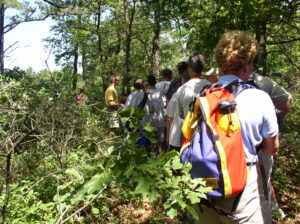
Third Step: Meal Prep/Plan!
- Remove any food that is in large packaging and repack it.
- Dehydrate your food
- Water!! Do not dehydrate! Carry at least 2 liters per person and also check to see if your trail has any natural springs.
- Protect your food! Animals can and will try to eat your food so pack it accordingly. If you’re in bear country then bear-proof your food.
The above steps would help you plan what food to bring on your backpacking trip, but when planning a practice day hike in the Pine Barrens, you usually do not need to bring any food and just a bottle of water will suffice. Always leave with what you bring!
Fourth Step: Packing!
When packing your backpack you want to pack it comfortably. Pack all heavy items near the center of your back and pack the lightweight items around that. This helps to keep you balanced. Any items such as snacks, keep in the side pockets for easy access.
- Lid: Maps, snacks, other essentials.
- Sides and top: Clothing, tent.
- Center: Water, food, cooking gear.
- Bottom: Sleeping bag.
- Outer: Sleeping pad.
The above steps will help you pack for a backpacking trip, but when planning a practice day hike in the Pine Barrens, it is not necessary to pack much of anything. Always bring a bottle of water and some basic emergency essentials for your day hike.
Lastly: Emergency Plan!!
- Never leave without telling a friend or relative!
- Leave your complete itinerary with someone back home.
- Carry a PLB (Personal Locator Beacon) This device will send a distress signal to local authorities and search and rescue teams.
- Problems will occur along the way, but with proper gear and knowledge, you can get yourself out of minor problems.
- Take a basic first aid course before you go!
The steps above will help you prepare you for backpacking trip emergencies. However, when planning a practice day hike in the Pine Barrens, much of the above does pertain and should be followed, but it is not necessary to go out and buy a PLB. Always be safe and let someone know where you are going and what trail you’ll be hiking before setting off on your day hike.

Man hiking in the Long Island Pine Barrens
Backpacking is fun and for those seeking adventure in the wild, but it is also serious and can be unsafe, so you must practice, plan, do your research and prepare. If you have never hiked before, but wish to backpack, then the Long Island Pine Barrens is the perfect place for you to practice. Conquer all of the Long Island Pine Barrens hikes and become familiar with the basics. Get in shape before backpacking and break in your footwear in the Pine Barrens to avoid blistering on that future backpacking trip.
By: Claire J Moran, Long Island Pine Barrens Society
Posted on August 11, 2020 by Long Island Pine Barrens Society
Five Questions with a Board Member
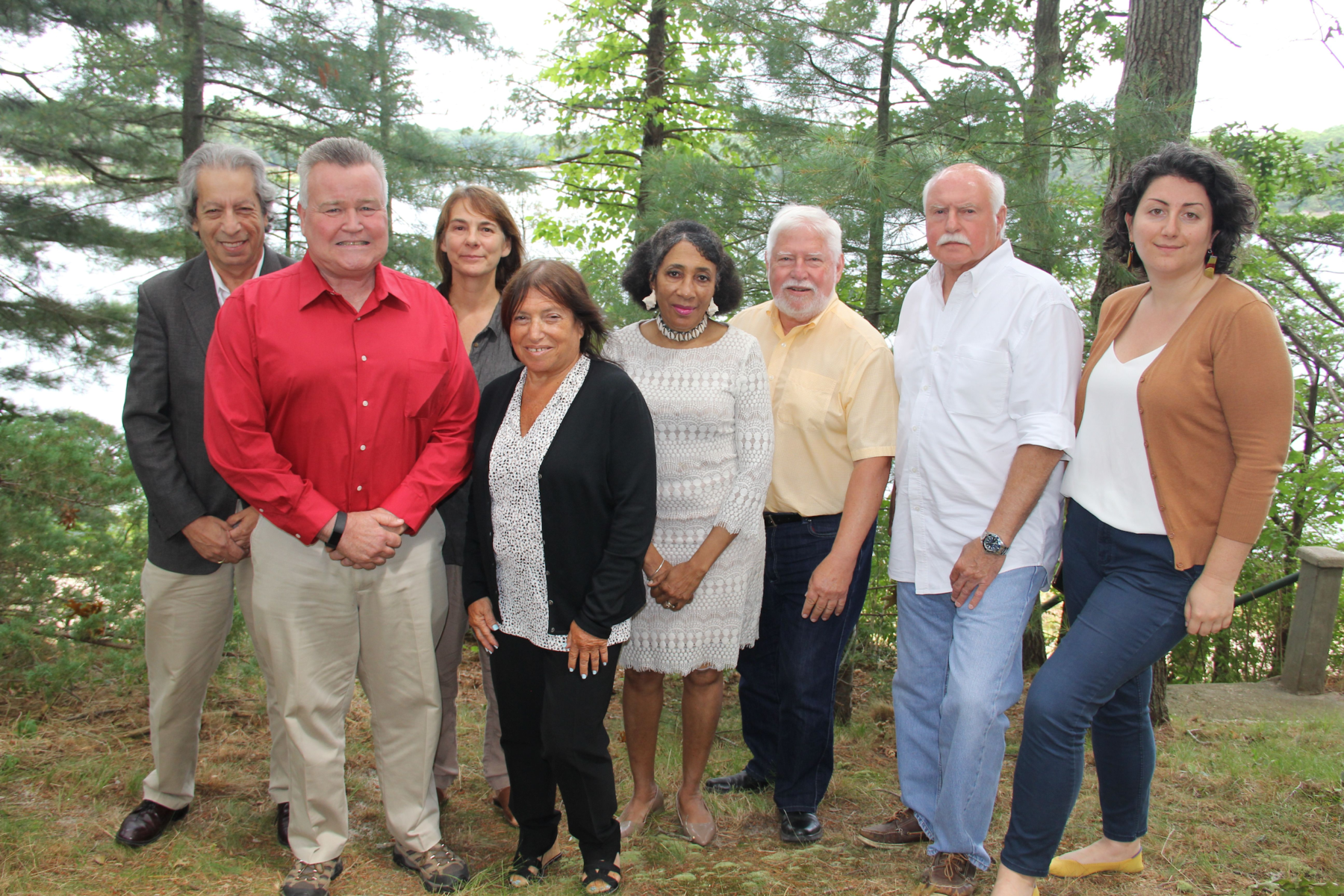
The Long Island Pine Barrens Society is officially launching a new blog feature called “Five Questions with an Environmentalist.” We will be interviewing a variety of people who are involved in protecting Long Island’s natural environment – advocates, scientists, artists, educators and more! Each person has their own unique perspective and we are excited to share their voices.
Our second post will feature Thomas (Tom) Casey, a Long Island Pine Barrens Society Board Member of our Board of Directors.
1. Please tell us about your background. How did you go from English teacher to naturalist?
I grew up in Woodside. For me, wildlife consisted of pigeons, sparrows and the rats along the Astoria waterfront. My love of the outdoors began in graduate school in Central New York, and later I started hiking in Harriman State Park. In 1974, I backpacked in Montana for the first of eight straight summers. Back home, I helped edit an edition of the New York Walk Book, and in the process discovered the L.I. Greenbelt Trail Conference and the diverse treasures of our open spaces. Most of what I’ve learned since has come from field guides and other reading, the familiarity that comes with visiting places repeatedly, and listening to those who knew more than I, most notably John Cryan, Bob McGrath and John Turner (the founders of the Pine Barrens Society) and the late Larry Paul.

Long Island Pine Barrens Society Board Member, Tom Casey.
2. You’re on the Society’s Board of Directors, but you’re also the Board President of Quogue Wildlife Refuge. Please tell us why you refer to QWR as the “Jewel of the Pine Barrens.”
Walking in Quogue Wildlife Refuge offers a short course in the entire Pine Barrens ecosystem, from tidal wetlands to bogs, upland barrens and dwarf pines—all in a compact space with well-maintained trails. A beautiful visitor center provides tranquil views of a historic ice pond.
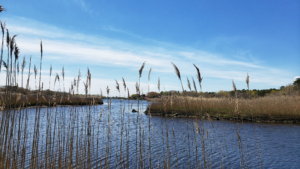
Quogue Wildlife Refuge
3. You’re a busy guy! You’re also the Vice President of the Long Island Greenbelt Trail Conference. Can you tell us about the work that you do with them?
I became involved with the Greenbelt in 1980, two years after its founding, and began leading hikes for the group in 1982. I’ve been doing so ever since, though the walks are a bit shorter now. Adding up Greenbelt hikes, summer courses on the trails for teachers, and occasional hikes for other groups, I suppose that’s about 2,000 hikes. I also have been editing and laying out the Greenbelt newsletter since 1983 and seen it grow from a small booklet to 16 and occasionally 20 pages. I’ve also given many library presentations about our trails. In every case I try to include some interpretive information to attract more Long Islanders to our open spaces. I’ve also worked on the trails, set up mailing label programs, taken meeting minutes, represented the Greenbelt on government committees, and gotten roped into other tasks.
4. What’s your favorite Pine Barrens Park and why is it your favorite?
I can’t choose one place, but several come to mind readily. Obviously, Quogue Refuge is always at or near the top of my list. I also like walking the Paumanok Path in Flanders from Pleasure Drive to Sears-Bellows County Park. It offers rolling terrain, Maple Swamp, Birch Creek, Owl Pond and an ever-changing landscape where nature repeatedly heals itself after bouts of various tree diseases. I also like to walk the Paumanok Path from Ridge to Manorville. Another beautiful spot is Hubbard County Park, where the Pine Barrens meet the bay, with gorgeous salt marshes and the “ghost forest” of ancient Atlantic White Cedars poking out of the shoreline.
5. You’ve led a lot of hikes and have taught a lot of people about the Pine Barrens. What’s one thing that you find people are always surprised (or interested) to learn about the Pine Barrens?
That it’s there. I frequently hear newbie hikers say, “Who knew all this existed?” They know it does on an intellectual level, but when they learn a little about how the ecosystem works or smell Sweet Fern or taste a Wintergreen berry, they get emotionally connected to the land. I never tire of hearing, “Who knew all this existed?”
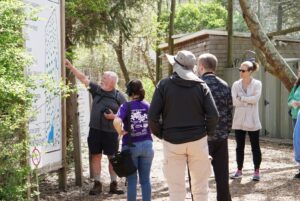
Quogue Wildlife Refuge Board President, Tom Casey, leading a hike through the QWR in 2019.
Help the Long Island Pine Barrens Society protect our natural treasures, make a contribution today!
Posted on August 3, 2020 by Long Island Pine Barrens Society

